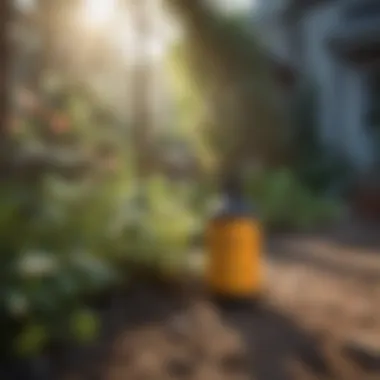DIY Insecticide: Crafting Eco-Friendly Solutions


Intro
In recent years, there has been a noticeable shift towards sustainable living. This transformation includes how we approach pest control in our homes and gardens. Many homeowners are now looking for ways to manage pests without relying on synthetic chemicals, which can pose health risks and have negative impacts on the environment. This article aims to provide a thorough guide on how to create your own insecticides using natural ingredients. By understanding the science behind these solutions, readers can take control of their pest management in an eco-friendly way.
Understanding DIY Insecticides
Before jumping into the creation of DIY insecticides, it is crucial to understand why they work. The efficacy of natural insecticides often stems from their active ingredients, which can overwhelm insect physiology or disrupt their biological processes without harming humans or pets. Ingredients like diatomaceous earth, essential oils, and vinegar can target specific pests effectively.
Key Ingredients
Some commonly used natural ingredients include:
- Diatomaceous Earth: A fine powder made from fossilized algae that damages the exoskeletons of insects, leading to dehydration.
- Neem Oil: Extracted from the seeds of the neem tree, this oil alters insect hormone systems, preventing them from mating and feeding.
- Essential Oils: Oils like peppermint or lavender can confuse or repel insects due to their strong scents.
Formulations and Recipes
Simple Recipes for Common Pests
When creating your insecticide, simplicity is often key. Here are a few effective formulations:
- Soap Spray:
- Peppermint Oil Spray:
- Garlic Spray:
- Combine 1 teaspoon of liquid soap (not detergent) with 1 quart of water.
- Shake well and spray directly on insects. This suffocates soft-bodied insects such as aphids and spider mites.
- Mix 10 drops of peppermint essential oil with 1 cup of water in a spray bottle.
- This solution deters ants and spiders.
- Blend 2 cloves of garlic with 1 cup of water.
- Let it sit overnight, strain, and use as a repellent against various insects.
"Natural pest control methods can be as effective as conventional methods when applied consistently and correctly."
Application Techniques
The effectiveness of any DIY insecticide greatly depends on the method of application. Here are a few tips to improve results:
- Timing: Apply during cooler parts of the day, such as early morning or late afternoon, to minimize evaporation.
- Coverage: Ensure all parts of the plant are covered, especially the undersides of leaves where pests often hide.
- Frequency: Reapply after rainfall, watering, or as needed, especially if pest populations remain high.
Safety and Precautions
While DIY insecticides are often less toxic than their synthetic counterparts, it is still important to follow safety precautions. Always label your mixtures, keep them out of reach of children and pets, and conduct a patch test on a small area of the plant before full application.
Epilogue
Prolusion to DIY Insecticide
Pest management is a crucial aspect for anyone who cultivates plants, whether it be in a garden, balcony, or indoor space. Understanding how to create your own insecticides can empower homeowners and gardening enthusiasts to tackle pest issues in an environmentally responsible manner. When faced with infestations, many might reach for commercial insecticides. These products can be effective, but they often carry risks due to their synthetic chemicals, which might harm beneficial insects and contaminate soil and water. Therefore, seeking alternatives is not only wise but necessary.
In this article, you will learn about the various facets of DIY insecticides, starting from their definition to how they can be made using common household ingredients. Through this exploration, you will discover the art of pest control without compromising ecological balance.
Definition of Insecticide
Insecticides are substances used to kill or control insect pests. They can be derived from natural sources or synthesized in laboratories. Natural insecticides, often labelled as "organic," can be derived from plants and essential oils, offering a gentler yet effective approach to pest control. Often, these formulations work by disrupting the life cycle or metabolism of pests, reducing their populations in a safe way.
Importance of Pest Control
Effective pest control is essential for sustaining healthy plants and gardens. Pests can damage foliage, fruits, and flowers, leading to significant economic losses for growers. A focused approach in managing these pests helps to promote a robust ecosystem. It is not only about dealing with existing infestations; proactive measures can significantly reduce the likelihood of future pest issues. By effectively controlling pest populations, one can ensure an abundant yield and a thriving garden.
Benefits of Making Your Own Insecticide
Creating your own insecticide comes with multiple advantages:
- Cost-Effective: Homemade solutions can be made from inexpensive or even free ingredients found around the home.
- Eco-Friendly: Many DIY insecticides incorporate natural ingredients, minimizing harm to the environment compared to chemical alternatives.
- Customization: Crafting your own formulas allows you to adjust concentrations and mixes based on the specific pest and situation at hand.
- Safety: Homemade solutions often present lower risks to human health and non-target species, including beneficial insects.
By understanding the constituents of homemade insecticides, you can tailor your approach to pest management, integrating it seamlessly into your gardening routine.


Understanding Pests
Understanding pests is crucial for effective pest management. Homeowners need to recognize the types of threats present in their gardens and homes. By knowing what pests are out there and how they operate, one can strategize the most effective preventive measures and remedies. The article dives deep into the world of pests, exploring both identification and types. It emphasizes the role of homeowners in maintaining healthy environments, fostering awareness of recurring issues, and reducing dependency on chemical solutions.
Types of Common Garden Pests
Pests can invade gardens at any time. Understanding the common types is the first step toward control. Here are a few notable foes that often plague garden ecosystems:
- Aphids: Small, soft-bodied insects that feed from plant sap, causing wilting and stunted growth.
- Spider Mites: Tiny arachnids that create webs on plants. They thrive in warm conditions and can cause significant foliage damage.
- Caterpillars: The larval stage of moths and butterflies, they can consume entire leaves quickly.
- Whiteflies: Often seen flitting around, they suck sap and excrete honeydew, which can lead to sooty mold.
- Slugs and Snails: These nocturnal pests create irregular holes in leaves. They thrive in damp environments, making them common in humid areas.
Researching these insects in further detail can help regain control of any pest-related issues.
Identifying Pest Infestations
Spotting a pest infestation early is vital for effective management. Identifying signs of damage and their source can save a garden from further degradation. Here are some simple ways to determine if pests have made themselves at home:
- Wilting Leaves: Plants that appear droopy or dried may indicate sap-sucking pests.
- Leaf Damage: Look for holes in foliage or discoloration, which can signal many types of infestations.
- Presence of Webs: Finding webs can suggest an issue with spider mites or other arachnids.
- Sticky Residue: Honeydew or sticky drops on leaves can be linked to aphids or whiteflies.
Taking time to examine plants routinely can prevent a small issue from escalating into a larger problem. A discerning eye is essential for maintaining cater and bug-free gardens.
"Identifying pests early allows for prompt action, minimizing damage and potential loss."
With this knowledge, homeowners can navigate their way through a pest problem, applying appropriate DIY solutions or adaptations as needed.
Natural Ingredients for Insecticides
Natural ingredients for insecticides offer a practical and sustainable alternative to commercial chemical solutions. Using these ingredients benefits both the environment and the safety of those using them. Insecticides derived from nature often have less harmful effects on non-target organisms, including beneficial insects, pets, and humans. With a growing emphasis on eco-friendly practices, understanding these natural components is critical for any homeowner or gardener looking to control pest populations effectively.
Essential Oils as Pest Repellents
Essential oils are concentrated plant extracts that can repel a variety of pests. Oils such as peppermint, lavender, and tea tree have proven efficacy against insects like mosquitoes, flies, and ants. This is due to their strong scents, which interfere with the insects' ability to navigate and find food.
For effective use, essential oils can be mixed with water and a mild soap. This mixture can then be sprayed directly on affected plants. Ensure to test a small area first to check for any adverse reactions from the plants.
Soap and Water Mixtures
Soap and water mixtures serve as a simple yet effective way to combat soft-bodied pests like aphids and spider mites. The soap works by breaking down the insect's protective outer layer, ultimately leading to dehydration and death.
To create this mixture, combine a few teaspoons of liquid soap, such as castile soap, with water in a spray bottle. It is important not to use detergent, as it may be too harsh for plants. This solution should be applied, ensuring to cover both the top and underside of leaves, where pests often hide.
Vinegar and Citrus Solutions
Vinegar, particularly apple cider vinegar, can create an effective pest deterrent when combined with citrus juice. This solution exploits the acidity of vinegar, which disrupts the pests' natural environment. Ants, for example, tend to avoid areas treated with vinegar.
To make this solution, mix equal parts vinegar and water, then add the juice of one lemon or orange. The citrus not only helps disguise the vinegar smell but may also enhance the effectiveness. Use this mix as a spray on affected areas, but be cautious, as vinegar can harm some plants if used excessively.
Garlic and Chili Peppers
Both garlic and chili peppers are notorious for their strong scents and flavors that deter various insects. The sulfur compounds in garlic have repellent properties, while the capsaicin in chili peppers irritates pests, discouraging them from feeding.
To create a garlic and chili solution, blend several cloves of garlic with a couple of chili peppers in water. Allow the mixture to sit for 24 hours, strain it, and then use it as a spray. Apply it in the early morning or late evening to avoid harming beneficial insects and to allow the mixture to adhere better to plant surfaces.
Using natural ingredients provides a safer way to manage pests, promoting an ecological balance in the garden.
In summary, utilizing natural ingredients for insecticides not only addresses pest issues effectively but also contributes to an eco-friendly gardening practice. Homeowners can achieve pest control without resorting to harmful chemicals, thus safeguarding both their health and the environment.
Recipes for DIY Insecticides
Crafting effective insecticides at home not only provides a sustainable approach to pest control but also empowers homeowners to take charge of their gardens and living spaces. Recipes for DIY insecticides are vital as they allow individuals to utilize readily available, natural ingredients without relying on potentially harmful chemicals. This section covers several recipes, each tailored for different pest issues, emphasizing the ease of creation, effectiveness, and safety of these homemade solutions.
General Purpose Insecticidal Soap
A general purpose insecticidal soap is an excellent starting point for many gardeners. This vinegar-natured spray is particularly effective against soft-bodied pests such as aphids, spider mites, and whiteflies. The underlying principle of this insecticide lies in the soap's ability to disrupt the protective outer coating of these insects, leading to dehydration and eventual death.
Ingredients Needed:


- 1 tablespoon of liquid soap (not detergent)
- 1 quart of water
Instructions:
- Mix the liquid soap and water in a container.
- Pour the mixture into a spray bottle.
- Shake well before use.
It is crucial to test this solution on a small plant area before a full application. This practice helps to ensure the plant's sensitivity to the soap. Apply it during the cooler parts of the day to avoid damage to the foliage.
Neem Oil Spray
Neem oil spray is a powerful option for those looking to manage pests in an eco-friendly manner. Derived from the seeds of the neem tree, this oil contains azadirachtin, a natural compound effective against various pests, including aphids and caterpillars. It works by disrupting the life cycle of insects, preventing them from feeding and growing.
Ingredients Needed:
- 2 tablespoons of neem oil
- 1 teaspoon of liquid soap
- 1 quart of water
Instructions:
- Combine neem oil, liquid soap, and water in a spray bottle.
- Shake the mixture until fully emulsified.
- Apply thoroughly to affected plants.
For optimum results, spray in the evening or early morning. People should repeat applications every week for the best control.
Garlic Spray Insecticide
A garlic spray insecticide harnesses the natural repellent properties of garlic. It is useful against a wide range of pests and can serve as a deterrent due to its strong aroma. Garlic not only repels insects but can also deter larger pests, adding yet another layer of protection.
Ingredients Needed:
- 2 bulbs of garlic
- 1 quart of water
- 1 teaspoon of liquid soap (optional)
Instructions:
- Blend the garlic cloves with water until smooth.
- Strain the mixture to remove the solid parts.
- Add soap if desired and pour it into a spray bottle.
- Shake well before applying.
Spray directly onto the plants, ensuring a thorough coating. This mixture is best used right after preparation for maximum potency.
Chili Pepper and Soap Mix
The chili pepper and soap mix is another effective recipe for insect management. The capsaicin in chili peppers acts as both a repellent and a deterrent to various pests, helping to keep plants safe from harm.
Ingredients Needed:
- 2 tablespoons of crushed red pepper
- 1 tablespoon of liquid soap
- 1 quart of water
Instructions:
- Combine crushed red pepper, liquid soap, and water in a spray bottle.
- Shake well and let the mixture sit for several hours or overnight to enhance potency.
- Strain the mix to prevent clogging of the spray nozzle.
- Apply to affected areas on plants.
As with other mixtures, use it during cooler parts of the day and monitor plant response closely.
These DIY solutions empowers you to manage your garden sustainably. Using them will help minimize environmental impact while protecting your plants.
Application Techniques for DIY Insecticides
Applying DIY insecticides effectively is crucial for achieving the desired pest control results. Understanding how and when to apply these solutions can significantly increase their effectiveness and minimize any potential harm to beneficial insects or your plants. This section will delve into best practices, timing, and safety measures that should be considered when applying your homemade insecticides.
Best Practices for Application
Effective application begins with the selection of the right method for distributing the insecticide. Here are some best practices:
- Use proper equipment: A spray bottle, garden sprayer, or a sponge can be effective, depending on the insecticide's viscosity and the surface area you want to treat. Ensure that your equipment is clean and serves its purpose without contamination.
- Target the pest directly: When applying the insecticide, aim for the areas where pests congregate. This enhances contact and boosts effectiveness.
- Coverage matters: Ensure all affected surfaces are covered thoroughly. This may require multiple passes for some recipes, especially those that are less viscous.
- Spray at appropriate distances: Keep the sprayer at a distance of 12-18 inches from the plant’s surface to allow for a fine mist to coat leaves thoroughly.
"Efficient coverage of your insecticide can mean the difference between success and failure in pest management."


Timing of Application
The timing of application is vital for pest control success. Consider these factors:
- Time of day: Early morning or late afternoon is often the best time for application. This helps avoid excessive sun exposure, which can degrade certain natural ingredients, particularly essential oils.
- Weather conditions: Avoid spraying during windy days, as this can lead to drift and reduced efficacy. Similarly, wait until after rain or dew has dried to prevent diluting your homemade insecticide.
- Pest life cycle: Understanding the pest’s lifecycle can help you apply insecticides when they are most vulnerable. For example, young larvae often are more susceptible than adult forms.
Safety Measures When Applying
While DIY insecticides often contain natural ingredients, safety should still be a priority. Keep these measures in mind:
- Protective gear: Wear gloves, goggles, and masks, particularly with strong ingredients like vinegar or essential oils. This prevents skin irritation and inhalation of fumes.
- Test on a small area: Before widespread application, test on a small portion of the plant to observe any adverse reactions. Wait for 24 hours to assess if the plant tolerates the homemade insecticide.
- Store safely: After application, store any leftover insecticide in a clearly labeled container and out of reach of children and pets.
Implementing these application techniques will help in using DIY insecticides more effectively, ensuring both the safety of your plants and the well-being of beneficial insects in your garden.
Evaluating Effectiveness
Evaluating the effectiveness of DIY insecticides is a critical aspect for homeowners who seek to control pests sustainably. Understanding how these homemade solutions perform allows you to make informed decisions about which recipes work best for your specific needs. An effective evaluation can lead to better pest control and save time and resources. In addition, this process helps in understanding the impact on the surrounding ecosystem.
Observing Changes in Pest Activity
Once you have applied your DIY insecticide, it is essential to monitor how pest activity changes over time. Start by establishing a baseline before treatment. This baseline can include noting the type and number of pests present in your garden or home. Regularly observe the treated areas and document any changes. Use a simple journal or app to track observations.
"Effective pest management involves not only the application of products but also ongoing observation and adjustments."
Within a few days of application, look for reduced insect presence. Are there fewer aphids on your plants? Are the ants less active? Take note of these changes. If your insecticide is working, you should observe a decline in pest populations. However, if you see no change or an increase, this indicates that you might need to reconsider your approach.
Adjusting Recipes Based on Outcomes
Adjustments are a natural part of the continually evolving process of pest management. If your initial DIY insecticide did not produce the desired results, consider modifying the recipe. This adjustment can involve altering the concentration of active ingredients or experimenting with different natural components.
For instance, if you used a garlic spray and noticed little impact on pests, try increasing the garlic content or mixing in another ingredient like dish soap. Alternatively, consider experimenting with other natural pest repellents, such as neem oil or essential oils like peppermint or lemon.
- Evaluate the specific pests you are targeting.
- Check for external factors that could influence effectiveness, such as weather conditions or plant health.
Taking notes during this phase is invaluable. Track what changes you made and the outcomes that followed. This iterative process enhances your understanding and leads to more effective DIY insecticides in the future.
Long-Term Pest Management Strategies
Effective pest control is not simply about managing existing infestations; it also involves implementing strategies that will prevent future problems. This is where long-term pest management strategies come into play, forming a fundamental part of any sustainable gardening or home care plan. By embracing these methods, homeowners can cultivate a more resilient environment that minimizes pest populations while fostering beneficial organisms.
Integrated Pest Management Principles
Integrated Pest Management (IPM) is a holistic approach that combines several techniques to manage pests effectively and sustainably. The principles of IPM emphasize understanding the interactions between pests, their environment, and the plants at risk. A major priority is to avoid reliance on chemical insecticides, promoting natural solutions.
- Monitoring: Regularly check your garden for signs of pests. This involves both visual inspections and setting traps. Keeping track of pest populations allows for timely responses.
- Identification: Knowing the specific pests affecting your plants is critical. Not all insects are harmful; understanding which ones pose threats can dictate your management strategies.
- Prevention: Enhance your plants' natural defenses by implementing diverse gardening practices, such as crop rotation and selecting pest-resistant varieties. These prevent situations that favor pest outbreaks.
- Control Methods: When pests are identified, utilize a combination of biological, mechanical, and cultural controls before resorting to pesticides. For example, attracting natural predators can help keep harmful populations in check.
In this way, IPM not only controls pests but also promotes a healthier ecosystem.
Encouraging Beneficial Insects
Another essential element of long-term pest management involves fostering relationships with beneficial insects. These creatures provide invaluable services in the garden, primarily through their roles as natural predators or pollinators. Encouraging their presence can greatly reduce pest problems and enhance plant health.
- Plant Diversity: A variety of flowering plants can attract beneficial insects. Choose plants that bloom at different times of the year to provide constant food sources.
- Shelter and Habitats: Provide places for beneficial insects to thrive. This might include native plant species, brush piles, or small water features.
- Avoiding Broad-Spectrum Insecticides: These chemicals can kill both pests and beneficial insects. Opt for targeted applications of your DIY insecticides, preserving the balance in your garden.
"A healthy ecosystem is marked by diversity, and within that diversity lies an essential balance crucial for managing pests."
In closing, long-term pest management strategies are imperative for sustainable gardening. They focus on understanding pest dynamics, utilizing natural control methods, and promoting beneficial insect populations. By investing in these approaches, homeowners can achieve more stable and resilient gardens.
Finale
The conclusion of this article serves as a pivotal reflection on the journey of understanding DIY insecticides. Throughout our exploration, we have delved into the essential principles and practices surrounding the creation and application of homemade pest control solutions. The importance of crafting these insecticides is evident not only in their effectiveness but also in their eco-friendliness. Homeowners can significantly benefit from utilizing natural ingredients that minimize harm to the environment while effectively addressing pest issues.
By emphasizing components such as essential oils, soap, and natural repellents, individuals are encouraged to adopt sustainable practices in their pest management strategies. Additionally, comprehending the science behind these ingredients enhances the overall efficacy of the solutions. For example, knowing how neem oil works against aphids allows gardeners to apply it with more precision and intention.
Incorporating DIY insecticides into regular pest control routines also promotes a deeper understanding of one’s surroundings. This fosters an appreciation for the ecosystem, encouraging the cultivation of beneficial insects and planting practices that support a healthier garden.
Ultimately, this article highlights the significance of taking a proactive approach to pest management through self-made solutions. As readers reflect on the insights shared, they are likely to realize that knowledge and preparation are as critical as the insecticides themselves. Engaging in this green practice not only contributes to personal gardens but also supports broader environmental goals.
Summary of Key Takeaways
- Understanding DIY insecticides is crucial for effective pest management in gardens and homes.
- Natural ingredients, such as essential oils and soap, offer a sustainable alternative to chemical products.
- Application techniques and proper timing are important for maximizing the effectiveness of these solutions.
- Monitoring and adapting pest control strategies enables ongoing success and resilience in dealing with infestations.
- Long-term strategies, including integrated pest management and encouraging beneficial insects, lead to healthier ecosystems.



